What's New
Displaying results 4811 - 4820 of 4914

Resource | Publications,
In spite of recent decades of unprecedented economic growth and industrialization in South East Asia, the bulk of economic activity is still based on agricultural production in rural areas. While urbanization continues to be a key demographic trend, most people still live in rural areas working in the agricultural sector. This is especially the case for Cambodia where an estimated 11.5 million people, or 80 per cent of the population, are living and working in rural areas. In Cambodia, as elsewhere in South East Asia, rural populations, due to their sheer size, must be at the center of any effective national programme to mitigate the socio-economic impact of HIV/AIDS.

Resource | Publications,
Many people see an effective preventive AIDS vaccine as the best solution to the HIV/AIDS pandemic. Ten years ago many scientists had hoped that a vaccine would be available by now. Most scientists are still optimistic that vaccines will be developed and many candidates are being tested. Strategies to implement HIV/AIDS vaccination need to be developed to be ready when vaccines do become available. The nature of those programs will depend on the characteristics of each vaccine.
Stover, Garnett, Seitz, and Forsythe use two computer simulation models to investigate the effects of various
vaccine characteristics and implementation strategies on the impact and cost-effectiveness of vaccines in different contexts.
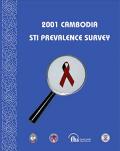
Resource | Publications,
Cambodia's response to its HIV/STI epidemic has included multisectoral awareness campaigns as well as more targeted interventions to improve STI management and reduce exposure in commercial sex settings. The Cambodian National Center for HIV/AIDS, Dermatology and STD (NCHADS) conducts surveillance at regular intervals to monitor biological and behavioral indicators of HIV.

Resource | Publications,
This report is part of a series of baseline surveys conducted to monitor the impact of HIV/STI prevention programmes in five states of India: Andhra Pradesh, Gujarat, Kerala, Orissa, West Bengal and in the Healthy Highways Project.
This report is a summary of the methodology and findings of the Gujarat HIV Risk Behavioural Surveillance Survey (BSS). This survey, which was a part of the impact assessment of HIV prevention activities in Gujarat, was conducted in late 1999, for the Gujarat State AIDS Control Society (GSACS).

Resource | Publications,
This report is part of a series of baseline surveys conducted to monitor the impact of HIV/STI prevention programmes in five states of India: Andhra Pradesh, Gujarat, Kerala, Orissa, West Bengal and in the Healthy Highways Project.
The Health Care Provider Survey (HCPS), Andhra Pradesh was conducted during November 1999 – September 2000. The purpose of this study was to collect baseline information on the quality of STI case management provided by health care providers (HCPs) in Andhra Pradesh.

Resource | Publications,
This report is part of a series of baseline surveys conducted to monitor the impact of HIV/STI prevention programmes in five states of India: Andhra Pradesh, Gujarat, Kerala, Orissa, West Bengal and in the Healthy Highways Project.
This report is a summary of the methodology and findings of the Healthy Highways Project (HHP) HIV Risk Behaviour Surveillance Survey (BSS). This survey was part of the impact assessment of HIV prevention activities in the HHP and was conducted in the year 2000.
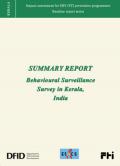
Resource | Publications,
This report is part of a series of baseline surveys conducted to monitor the impact of HIV/STI prevention programmes in five states of India: Andhra Pradesh, Gujarat, Kerala, Orissa, West Bengal and in the Healthy Highways Project.
This report is a summary of the methodology and findings of the Kerala HIV Risk Behavioural Surveillance Survey (BSS). This survey was part of the impact assessment project of HIV prevention activities in Kerala and was conducted in late 1999 for the Kerala State AIDS Control Society (KSACS).
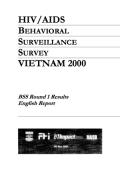
Resource | Publications,
The Behavioral Surveillance Survey (BSS) was introduced in Vietnam in 2000 to compliment the extensive sero-prevalence and passive HIV surveillance systems instituted nationally. Vietnam is currently experiencing an HIV epidemic 'concentrated' primarily in populations with specific high-risk sexual and injecting drug practices. Behavioral surveillance was conducted in five provinces - Hanoi, Hai Phong, Da Nang, HCMC, and Can Tho.
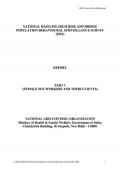
Resource | Publications,
BSS in the general population and high-risk groups is proposed to be undertaken thrice during the period 2001-2005.
The present report details the observations of the national baseline BSS survey among high risk and bridge groups, female sex workers and clients of female sex workers, which was conducted in 32 States and Union Territories of the country. This baseline provides basic information needed to strategize and prioritise programs under NACPII during its five years of implementation.
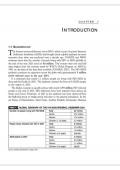
Resource | Publications,
Behavioral Surveillance Survey provides repeated measures in behavioral indicators for observing trends in high-risk behavior among the specific sub-population groups based on cross-sectional surveys.
The present report provides the detailed findings of the baseline survey conducted among the bridge group (Client of Female Sex Workers) and one high-risk population group (Female Sex Workers) seeking their present status on awareness, knowledge, attitude and behaviour with regard to STD/HIV/AIDS. The study has been conducted in 32 States and Union Territories of India.





